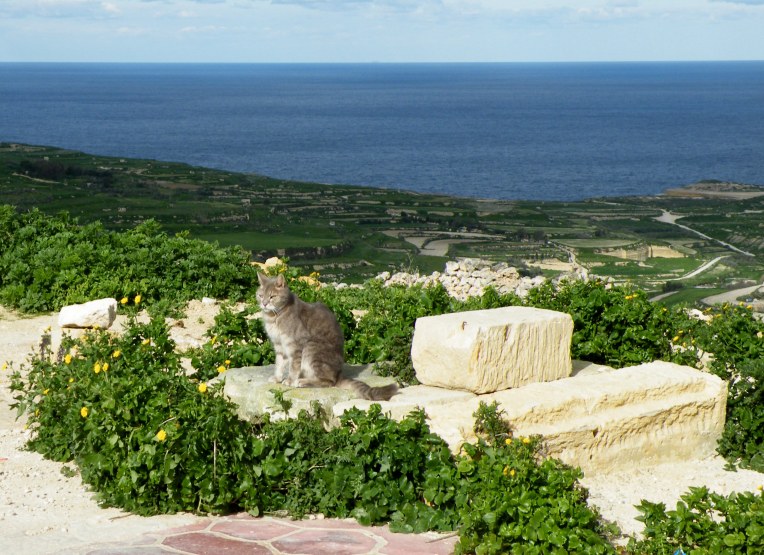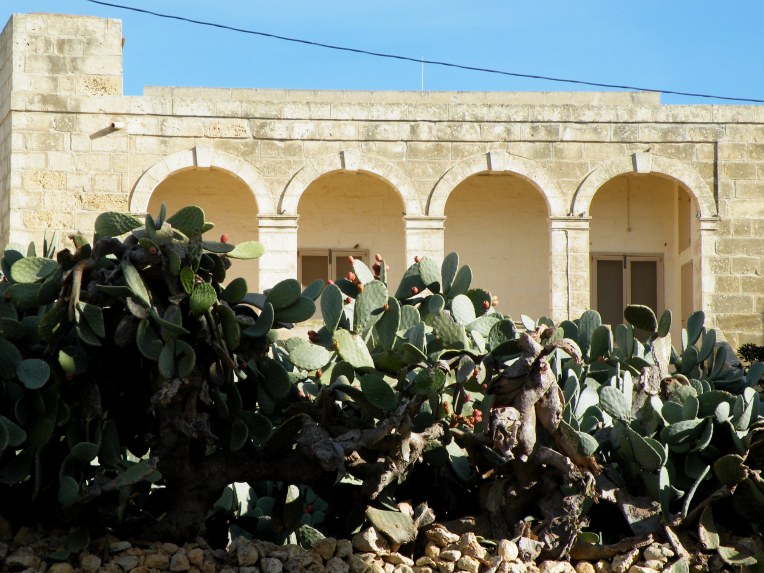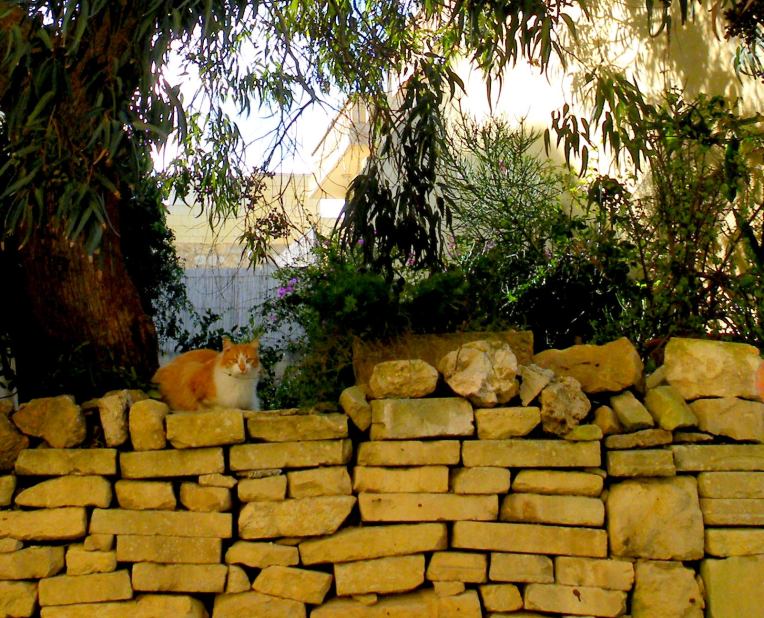Zebbug is a village in an elevated area on the North coast of Gozo. It was a Wednesday morning when I visited, everything was quiet, I saw no one when I got off the bus and I was the only person riding on the bus too. So tranquil was this place, everything was shut, that is except the church for which I headed, crossing over a large empty square I reached the steps leading up to an impressive Baroque façade of the village church, I was on a mission, to go and see the beautiful interior which is made up mainly of locally quarried brown Onyx stone, and the book where I read about it did not let me down, I was very impressed and delighted to be able to see this, and to touch this semi-precious stone. I found myself looking at the altar, the confession chair, the pillars, holy water container, a statue, the chairs for the priests, everything made out of Onyx stone, it looked amazing. Yet again I am finding that the ‘stones’ or rocks found on Gozo are very pleasing to the eye!
So I walked on along one of the streets and took in all that was to see, soon I got glimpses of the sea and the beautiful green agricultural landscape along the coast, I found it interesting to see lots of fields like patchwork, the land was being worked by some farmers I noticed. I read that Zebbug derives its name from the Maltese word referring to the Olive tree. The village is also known for its lace making, its weaving and its woollen blankets, but I did not see any of this when I went, no shops were open. The village was quiet, there was a vegetable van driving around, I bought a very tasty orange from him, a few people were gathered around this van buying stuff. There was also a gas delivery truck driving around blowing the horn at intervals as is done here in Gozo. It was when I saw a bread van that I decided to check out if it carried ‘Ghazziela’ I had read about it and had to see one, it’s a biscuit in the shape of the ‘M’ for mother Mary, tradition is to hang it behind the door of your house in order to protect the place from storms and lightning. These biscuits are blessed after they are baked. Of course the bread van lady did not have them, they are not for eating! However, a kind lady standing beside me and hearing me ask for the Ghazziela offered to have a look for some in her house, she did come out with two of them and gave them to me, we had a chat after that and she and her sister really made the visit to Zebbug a very memorial one, so kind and helpful people are, I am experiencing this all the time, it warms the heart. The kindness of these two ladies will not be in vain, it has touched me and showed me once again that people have such good hearts, humankind is not a failure, if we let our hearts speak then kindness has no bounds, it made me happy to mull over these thoughts on my way home.
I took many photos, some of which I will share here, but there is still much more beauty to find in this tranquil village, I’m so glad that I went there.
The two Ghazziela gifts I received from the kind ladies, and on the right this is the inside of a Prickly Pear cactus leaf, people use this material in making jewellery.

A street leading towards the blue water, and butternut squash drying in the sun.
These four photos are of the village church and its Onyx interior.
I saw grapes hanging over the wall in a village street, and little country lanes lead out from the village to the pastoral land below in the valley.

This village has its fair share of arches which I love so much, I hope that they can always be preserved.

Greenery looks so nice against the limestone walls.

This cat did not have to say much for herself, she was just soaking up the few rays of sunshine on this winter day. You are never short of cats on Gozo, and they are beautifully coloured animals.












Reblogged this on Wanda D. Jefferson and commented:
So many beautiful and serene pics…gaianaction blog is full of pure peace.
LikeLiked by 1 person
Oh thank you so much Wanda, so kind of you, and happy you enjoyed.
LikeLiked by 1 person
beauty and serenity at its best
LikeLiked by 1 person
Thank you for your kind comment Wanda.
LikeLiked by 1 person
YW…Blessings!
LikeLiked by 1 person
Looks like a beautiful place.
LikeLiked by 1 person
A lovely area indeed!
LikeLiked by 1 person
Thanks for bringing me on such a peaceful outing. A delight.
LikeLiked by 1 person
Very welcome Jean, a delight to have you along.
LikeLiked by 1 person
I can imagine that there were photo opportunities everywhere you looked. Thank you for sharing.
LikeLiked by 1 person
You guessed right Mary 🙂
LikeLike
Your post and your pictures are amazing as always. I feel quite often like I’m right there with you, drawn into the story you tell as my eyes take in all the subjects of which you speak. But fair warning, those lovely-looking Prickly-pear cactus at one time (thanks to a misguided attempt to use them to produce dye) were almost single-(leafedly?) the demise of a good portion of the continent of Australia. Just a couple descriptive lines from a Wikipedia article about that time have this to say about them,
“…in an attempt to establish a cochineal dye industry. They quickly became a widespread invasive weed, eventually converting 101,000 sq mi (260,000 km2) of farming land into an impenetrable green jungle of prickly pear, in places 20 ft (6.1 m) high. Scores of farmers were driven off their land by what they called the “green hell”; their abandoned homes were crushed under the cactus growth, which advanced at a rate of 1,000,000 acres (4,046.9 km2; 1,562.5 sq mi) per year.”
Anyway, they used caterpillars (a variety of the living kind, not the tractors) to finally get things under control, and all was well that ended well. So I hope this comment wasn’t too long, I just thought you might like to know that little bit of their history since I saw quite a few of them (and they are beautiful) on the walk you took us on. If you are interested in knowing any more of that story (it’s very interesting) the link is as follows:
https://en.wikipedia.org/wiki/Opuntia , and the sub-heading that contains the actual history dealing with the above story is “Ecology”.
LikeLiked by 1 person
My thank you so much David, how very interesting this is, never knew any of that and will follow your link to read more. So they grow very fast then, these cati. Plants or animals that are introduced into an environment not their own mostly end up being invasive and destructive, and give a lot of trouble even to the detriment of the native plants and animals. It was great of you to share this information, thank you very much David, much appreciated!
LikeLiked by 1 person
You are very welcome. I just thought it was fascinating that something so beautiful could also become so troublesome.
LikeLiked by 1 person
It is like the rhododendron in Ireland David, it gives those most beautiful lilac flowers, it was introduced into Ireland and soon took over native forests and while beautiful it did kill or restrict the native trees, so a lot of it had to be cut down and controlled.
LikeLiked by 1 person
So we have to be very careful when transplanting beauty. Maybe it’s better to wait until we can go TO it. : )
LikeLiked by 1 person
Yes it is good to be responsible in these matters isn’t it.
LikeLiked by 1 person
I always look forward to your photos of the island. It really seems to be a special place. I do have to ask, what is a gas truck? Is it gasoline for cars or propane for houses?
LikeLiked by 1 person
It is propane for houses which is delivered at the doors here, most people seem to use it for cooking, or sometimes heating too, it is bottled. And thanks for your comment!
LikeLiked by 1 person
Yes, we use it in areas that cannot have natural gas piped to houses. During a hurricane evacuation, we had gasoline tankers that could fill up cars on the highway.
LikeLiked by 1 person
Yes that is a clever idea if necessary. As far as the propane gas goes, I never expected to take to it the way I did, in Ireland I cook with electricity. Here we have been using bottled gas and have done over three months with one bottle, not bad going and cheap 🙂
LikeLiked by 1 person
very enriching information—–thank you for sharing
waiting to read more of whatever you place you visit 🙂
LikeLiked by 1 person
Thank you very much for your kind comment, there will be more coming for sure… 🙂
LikeLiked by 1 person
I’m sure and waiting eagerly
LikeLiked by 1 person
A beautiful record, in words and pictures. Even though not a cat lover, I thought that last shot perfect.
LikeLiked by 1 person
Thank you Derrick, cats you see all around the place here, they usually have beautiful colouring, many are feral. Glad you like that shot of them, some are very photogenic.
LikeLiked by 1 person
thank you for taking me for a walk in a sunny little town with green plants, dear Agnes, as it is snowing here and quite cold. Wonderful photos. Wishing you a good new year and lots of fun in Malta, kind regards Mitza
LikeLiked by 1 person
Thank you dear Mitza for your kind wishes, sending you likewise wishes for a wonderful and blessed new year! Sending you lots of sunny greetings from Gozo. Keep warm and also enjoy the snow.
LikeLiked by 1 person
:)))
LikeLiked by 1 person
What a beautiful place with kind people.Well done the story and the photos
LikeLiked by 1 person
Thank you, most enjoyable it all was.
LikeLike
Very beautiful. Thank you for sharing your pictures.
LikeLiked by 1 person
Thank you Julia, and very welcome!
LikeLike